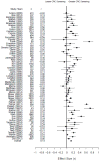Does colorectal cancer risk perception predict screening behavior? A systematic review and meta-analysis
- PMID: 26280755
- PMCID: PMC4628847
- DOI: 10.1007/s10865-015-9668-8
Does colorectal cancer risk perception predict screening behavior? A systematic review and meta-analysis
Abstract
Although health behavior theories postulate that risk perception should motivate colorectal cancer (CRC) screening, this relationship is unclear. This meta-analysis aims to examine the relationship between CRC risk perception and screening behavior, while considering potential moderators and study quality. A search of six databases yielded 58 studies (63 effect sizes) that quantitatively assessed the relationship between CRC risk perception and screening behavior. Most included effect sizes (75 %) reported a positive association between CRC risk perception and screening behavior. A random effects meta-analysis yielded an overall effect size of z = 0.13 (95 % CI 0.10-0.16), which was heterogeneous (I (2) = 99 %, τ(2) = 0.01). Effect sizes from high-quality studies were significantly lower than those from lower quality studies (z = 0.02 vs. 0.16). We found a small, positive relationship between CRC risk perception and reported screening behavior, with important identified heterogeneity across moderators. Future studies should focus on high quality study design.
Keywords: Colorectal neoplasms; Early detection of cancer; Meta-analysis; Patient-reported outcomes; Perceived risk.
Figures
References
-
- American Cancer Society. [Accessed 31 July 2015];Cancer Facts & Figures 2015. Available from: http://www.cancer.org/acs/groups/content/@editorial/documents/document/a....
-
- Baier M, Calonge N, Cutter G, McClatchey M, Schoentgen S, Hines S, Ahnen D. Validity of self-reported colorectal cancer screening behavior. Cancer Epidemiol Biomarkers Prev. 2000;9:229–232. - PubMed
Publication types
MeSH terms
Grants and funding
LinkOut - more resources
Full Text Sources
Other Literature Sources
Medical




